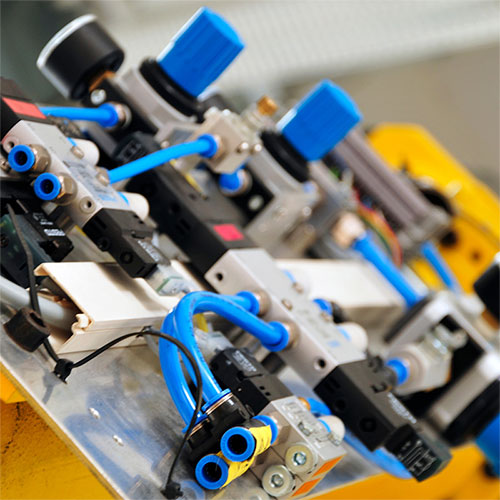Harmony in Motion: The Seamless Integration of Pneumatic Control Systems
How Pieces of Pneumatic Control Systems Work Together
 To create a seamless narrative of how these pneumatic components interlink and function as a cohesive unit, we'll explore each part's role in greater detail and illustrate how they transition into one another within the operational sequence of a pneumatic control system.
To create a seamless narrative of how these pneumatic components interlink and function as a cohesive unit, we'll explore each part's role in greater detail and illustrate how they transition into one another within the operational sequence of a pneumatic control system.
- Pneumatic Control Systems: A pneumatic control system is an intricate dance of air-powered components working harmoniously to control mechanical operations. Actuators, sensors, and valves form the physical groundwork of this system, transforming compressed air into mechanical action that drives machinery. The conductor of this symphony is the controller, often a PLC, which interprets sensor data to modulate the actuators' movements. For instance, in manufacturing, the system might use air pressure to move a piston, with the PLC adjusting the piston's speed and force in real time, based on feedback from pressure sensors.
- Pneumatic Controls: These controls are the precision tools that dictate the nuanced behavior of the system. Transitioning from the centralized control exerted by the PLC, pneumatic controls like solenoid valves implement these instructions, directing airflow to the right place at the right time. This localized control is exemplified in applications such as an automated painting system, where solenoid valves ensure paint is released at precise intervals to achieve uniform coverage.
- Pneumatic Counters: Functioning as the meticulous record-keepers of the system, pneumatic counters log each cycle or step in a process. These counters bridge the gap between the physical movements of machinery and the data-driven oversight required for efficiency and maintenance. For example, in a packaging facility, counters tally the number of filled containers, ensuring the operation stays on track and signaling when scheduled maintenance may be due based on the number of cycles completed.
- Pneumatic Indicators: The indicators act as the communication link between the machine's state and the operator. They illuminate the transition points within the system's operation, such as indicating when a batch process is complete or if a pressure drop requires attention. Consider a situation where a reduction in air pressure could compromise product quality; an indicator would alert operators before this becomes an issue, allowing for a timely intervention.
- Pneumatic Timers: Timers are the metronomes that ensure that each step in the pneumatic sequence occurs at the correct tempo. They are critical in scenarios requiring precise timing, like the coordination between multiple actuators in an assembly line, where they maintain rhythm and flow, ensuring components are assembled in the right sequence and duration.
The Use of Pneumatic Control Systems in the Real-World
Pneumatic control systems are a staple in many industries, revered for their reliability, simplicity, and inherent safety. Among their myriad applications, three areas stand out for their common and impactful use of pneumatics: manufacturing automation, transportation systems, and medical devices.
- Manufacturing Automation: In manufacturing automation, pneumatic systems are indispensable. They drive the operation of machinery, manage the conveyance of products along assembly lines, and power robotic arms for various tasks, including welding, painting, and the precise placement of components. The preference for pneumatics in such settings stems from their ability to generate fine-tuned and robust movements tailored to the task at hand. Pneumatic actuators can be designed to handle delicate components with care or provide the substantial force required for heavy lifting. Their robustness is especially valued in potentially explosive environments where electric sparks pose a significant risk; pneumatics offer a spark-free alternative. The durability and low maintenance of pneumatic systems further justify their widespread adoption in manufacturing, ensuring uninterrupted operations and thereby enhancing productivity.
- Transportation Systems: Transportation systems also leverage the advantages of pneumatic technology. For example, the braking systems of trucks and trains rely heavily on pneumatic controls. Compressed air exerts force on brake pads in these applications, slowing down or halting the vehicles. The sophistication of pneumatic systems allows for fine modulation of pressure, which is critical for the safe operation of these large and heavy vehicles. Air brakes are advantageous because, unlike hydraulic systems, a leak in a pneumatic system doesn't pose a fire hazard or result in environmental contamination since the working fluid is simply air.
- Medical Devices: The medical sector further illustrates the versatility of pneumatic systems. In hospitals and clinics, these systems are at the heart of numerous devices that support patient care, from lifts that provide mobility assistance to sophisticated respiratory machines that support patients' breathing. Dental and surgical instruments often rely on pneumatic technology for precision and control. The absence of electromagnetic emissions makes pneumatics particularly suitable for the medical environment, where they won't interfere with sensitive medical equipment. Moreover, the ability to sterilize pneumatic devices ensures compliance with the stringent hygiene standards required in medical settings, while the gentle operation of these systems ensures patient safety and comfort.
The prevalence of pneumatic systems across these critical sectors is a clear indicator of their unmatched utility. Offering a blend of control, efficiency, and safety, pneumatics are a preferred solution for powering and controlling a wide array of machinery and processes.
Related Reading


- Ellis/Kuhnke Controls
132 Lewis Street Unit A-2, Eatontown, N.J. 07724
Phone: 1-800-221-0714
Fax: 732-291-8154
Email: Info@ekci.com
- Home Pneumatic Controls Technical Info CAD Drawings Contact Us Pneumatic Timers Blog Site Map
